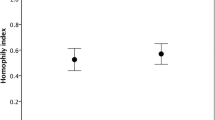Abstract
Three studies were conducted to evaluate the significance of the finding that females are more disclosing in their same-sex friendships than are males. No support was found for the suggestion that males feel just as close to their same-sex friends as do females. However, there was support for a developmental contention that during adolescence both sexes expect to become more disclosing in their other-sex friendships in adulthood, and that the spousal relationship should be the most intimate. Further, both sexes, whether in the United States or Hungary, believe females are more disclosing of their feelings and problems than are males. Although males do seem to wish to be more disclosing, they expect to be more open mainly in other-sex friendships. The majority of adults profess little concern about disclosure in same-sex friendships, but women report feeling more at ease in relating to other women than to men.
Similar content being viewed by others
References
Berndt, T. J. (1982). The features and effects of friendship in early adolescence. Child Development, 53, 1447–1460.
Booth, A. (1972). Sex and social participation. American Sociological Review, 37, 183–192.
Caldwell, M. A., & Peplau, L. A. (1982). Sex differences in same-sex friendship. Sex Roles, 8, 721–732.
Clark, M. S., & Reis, H. T. (1988). Interpersonal processes in close relationships. Annual Review of Psychology, 39, 609–672.
Crawford, M. (1977). What is a friend? New Society, 42, 116–117.
Crohan, S. E., & Antonucci, T. C. (1989). Friends as a source of social support in old age. In R. G. Adams & R. Blieszner (Eds.), Older adult friendship: Structure and process. Newbury Park, CA: Sage.
Davidson, S. L. (1978). The therapeutic dimensions of friendship between women. Dissertation Abstracts, 39(1-A), 192.
Derlega, V. J., Winstead, B. A., Wong, P. T. P., & Hunter, S. (1985). Gender effects in an initial encounter: A case where men exceed women in disclosure. Journal of Social and Personal Relationships, 2, 25–44.
Diamond, M., & Karlen, A. (1980). Sexual decisions. Boston: Little, Brown & Co.
Dickens, W. J., & Perlman, D. (1981). Friendship over the life cycle. In S. Duck & R. Gilmour (Eds.), Developing personal relationships. London: Academic Press.
Eder, D., & Hallinan, M. T. (1978). Sex differences in children's friendships. American Sociological Review, 43, 237–250.
Erikson, E. H. (1968). Identity: Youth and crisis. New York: Norton.
Helgeson, V. S., Shaver, P., & Dyer, M. (1987). Prototypes of intimacy and distance in same-sex and opposite-sex relationships. Journal of Social and Personal Relationships, 4, 195–233.
Hojat, M., & Vogel, W. H. (1989). Socioemotional bonding and neurobiochemistry. In M. Hojat & R. Crandall (Eds.), Loneliness: Theory, research, and applications. Newbury Park, CA: Sage.
Kaufman, D. R. (1978). Associational ties in academe: Some male and female differences. Sex Roles, 4, 9–21.
Kon, I. S. (1981). Adolescent friendship: Some unanswered questions for future research. In S. Duck & R. Gilmour (Eds.), Developing personal relationships. London: Academic Press.
Kon, I. S., & Losenkov, V. A. (1978). Friendship in adolescence: Values and behavior. Journal of Marriage and the Family, 40, 143–155.
Laosa, L. M., & Brophy, J. E. (1972). Effects of sex and birth order on sex-role development and intelligence among kindergarten children. Developmental Psychology, 6, 409–415.
Levinson, D. J. (1978). The seasons of a man's life. New York: Alfred A. Knopf.
Lowenthal, M. F., & Haven, C. (1968). Interaction and adaptation: Intimacy as a critical variable. American Sociological Review, 33, 20–30.
Lowenthal, M. F., Thurnher, M., Chiriboga, D., & Associates (1975). Four stages of life. San Francisco: Jossey-Bass.
Lyness, J. F. (1978). Styles of relationships among unmarried men and women. Sociological Abstracts, 26, 1249.
Powers, E. A., & Bultena, G. L. (1976). Sex differences in intimate friendships of old age. Journal of Marriage and Family, 38, 739–747.
Reis, H. T. (1984). Social interaction and well-being. In S. Duck (Ed.). Repairing personal relationships. London: Academic Press.
Reis, H. T., Senchak, M., & Solomon, B. (1985). Sex differences in the intimacy of social interaction: Further examination of potential explanations. Journal of Personality and Social Psychology, 48, 1204–1217.
Reis, H. T., & Shaver, P. (1988). Intimacy as an interpersonal process. In S. Duck (Ed.), Handbook of personal relationships: Theory, relationships and interventions. Chichester: John Wiley & Sons.
Reisman, J. M. (1971). Toward the integration of psychotherapy. New York: Wiley-Interscience.
Reisman, J. M. (1981). Adult friendships. In S. Duck & R. Gilmour (Eds.), Developing personal relationships. London: Academic Press.
Reisman, J. M. (1983). SACRAL: Toward the meaning and measurement of friendliness. Journal of Personality Assessment, 47, 405–413.
Reisman, J. M. (1988). An indirect measure of the value of friendship for aging men. Journal of Gerontology: Psychological Sciences, 43(4), 109–110.
Reisman, J. M., & Billingham, S. (1989). SACRAL: Additional correlates of a self-report measure of friendliness-unfriendliness. Journal of Personality Assessment, 53, 113–121.
Rothman, E. K. (1984). Hands and hearts. New York: Basic Books.
Rubin, L. B. (1983). Intimate strangers: Men and women together. New York: Harper & Row.
Rubin, Z. (1980). Children's friendships. Cambridge: Harvard University Press.
Sharabany, R., Gershoni, R., & Hofman, J. E. (1981). Girlfriend, boyfriend: Age and sex differences in intimate friendship. Developmental Psychology, 17, 800–808.
Waldrop, M. F., & Halverson, C. F. (1975). Intensive and extensive peer behavior: Longitudinal and cross-sectional analysis. Child Development, 46, 19–26.
Wheeler, L., Reis, H. T., & Nezlek, J. (1983). Loneliness, social interaction, and sex roles. Journal of Personality and Social Psychology, 45, 943–953.
Winstead, B. A. (1986). Sex differences in same-sex friendships. In V. J. Derlega & B. A. Winstead (Eds.), Friendship and social interaction. New York: Springer Verlag.
Yoon, G. H. (1978). The natural history of friendship: Sex differences in best-friendship patterns. Dissertation Abstracts, 39(3-B), 1553.
Author information
Authors and Affiliations
Rights and permissions
About this article
Cite this article
Reisman, J.M. Intimacy in same-sex friendships. Sex Roles 23, 65–82 (1990). https://doi.org/10.1007/BF00289880
Issue Date:
DOI: https://doi.org/10.1007/BF00289880




